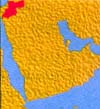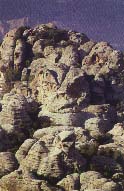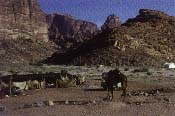Chris Bradley
Pictures by R.F. Porter
 Jordan is relatively small in area yet the tremendous variety of
terrain offers visitors a great deal of nature and wildlife possibilities.
Between the lowest point on the earth's surface and the lofty
heights of the eroded sandstone peaks above Wadi Rum are climatic
and geological differences suitable to a whole range of flora
and fauna. The larger species are mainly concentrated into the
three wildlife reserves of Azraq, Shaumari and Wadi Mujib. The
first two are located in the 'Badia' region, a semi arid land
in the north east, bordering Syria. Vegetation ranges from hardy
acacia on the low semi-desert plains to juniper forests covering
the snow-covered winter slopes above 1000 metres. In between are
a wide range of trees, shrubs and flowers (particularly anemones,
cyclamen and poppies) which colour the landscape from February
to May. The black iris is the national flower and can be found
growing wild on the plateaus, especially around Madaba.
Jordan is relatively small in area yet the tremendous variety of
terrain offers visitors a great deal of nature and wildlife possibilities.
Between the lowest point on the earth's surface and the lofty
heights of the eroded sandstone peaks above Wadi Rum are climatic
and geological differences suitable to a whole range of flora
and fauna. The larger species are mainly concentrated into the
three wildlife reserves of Azraq, Shaumari and Wadi Mujib. The
first two are located in the 'Badia' region, a semi arid land
in the north east, bordering Syria. Vegetation ranges from hardy
acacia on the low semi-desert plains to juniper forests covering
the snow-covered winter slopes above 1000 metres. In between are
a wide range of trees, shrubs and flowers (particularly anemones,
cyclamen and poppies) which colour the landscape from February
to May. The black iris is the national flower and can be found
growing wild on the plateaus, especially around Madaba.
Azraq (Mahmiyat el Azraq)
110 kms east of Amman is the site of one of the famous 'desert
castles'. Qasr Azraq was built around 300 AD to control access
to the nearby springs (azraq means blue) which feed the only large
body of water in Jordan's Eastern Desert, and as such, has attracted
wildlife and migrating birds to the area for millennia. Over a
thousand years ago some of the Umayyad caliphs visited the region
to hunt asiatic lion, gazelle and horse. The last lion was shot
in the 1920s, but there are still some hardy horses to be seen
in this 'desert Camargue'.
During winter, the nearby mud flats are submerged, but each summer the water evaporates to reveal tons of raw salt. The collection and selling of this salt supports a small village. Ducks and waders are attracted to the flooded region when the eggs of small, salt-tolerant fish (Aphanius dispar) hatch.
The reserve itself is now situated along the eastern side of the main highway to Iraq. A collection of open water pools, meadows, marshes and silt dunes form one of Jordan's most important ornithological sites. During spring and autumn migrations, in excess of 300 species have been observed, including 15 species of duck. Other visitors include storks, cranes, herons, falcons, hawks, swallows and wagtails.
The marshy reed areas are also home to large numbers of water buffalo (Bubalus bubalus) which wander freely around the 12 sq kms reserve. In the harsh desert climate it is amazing to think that there are more species of flowering plants than there are bird species. Over 350 have been recorded in and around the wetlands. The silt dunes are covered by thick clumps of tamarisk and nitraria bushes, which together with the giant reeds offer protection for snakes, lizards and frogs. Jackals and red foxes can sometimes be seen, and occasionally striped hyaena.
For further information and visiting arrangements contact The Royal Society for the Conservation of Nature. Most visitors travel to the Azraq sites for the day, but there is accommodation available locally.
The As-Sayad (Hunters) Hotel is located on a wooded hill, just 300m south of Qasr Azraq. It has 20 double and triple rooms, two swimming pools, restaurants and bar (Tel (06) 647611/0 Fax (06) 644988, PO Box 830633, Amman 11183).
The Government Resthouse is midway between the Amman junction and the As-Sayad Hotel. There are 24 double rooms and a restaurant (Tel (06) 647611/6.
The RSCN Resthouse in Azraq South is reserved for members and guests of the society and is mainly used at weekends.
Shaumari Wildlife Reserve (Mahmiyat Wadi esh Shaumari)
Just 12 kms to the south of Azraq on the opposite side of the
main highway to Saudi is Shaumari. Slightly larger than Azraq
at 22 sq kms, Shaumari is totally different to its near neighbour.
This sandy hammada area is much more suited to the breeding and
propagation programmes designed to protect and re-introduce species.
The main thrust concerns the endangered Arabian oryx (Oryx leucoryx),
several species of gazelle, ostrich and onager.
With the backing of the Worldwide Fund for Nature, the RSCN is approaching its 30th anniversary of managing the site. By far the most successful project is its participation in 'Operation Oryx' - the formation of a breeding herd of these elegant antelopes in an area from which the species had disappeared some 50 years earlier. Shaumeri has played an important role in the international project which has rescued the Arabian oryx from extinction through a multinational captive breeding programme.
A visit to one of the observation towers at Shaumari today should reward the visitor with views of gazelle and oryx, as well as ostrich and onager, two other 'rescued' species. The onager (Equus hemionus onager) is a relative of the now extinct wild ass (Equus hemionus hemippus) which once lived in the region. Other animals to be seen at the reserve are Cape hare, red fox, gerbil and even striped hyaena and wild cat.
Accommodation for visitors is listed under the section on Azraq, above.
 Wadi Mujib (Mahmiyat Wadi Mujib)
Wadi Mujib (Mahmiyat Wadi Mujib)
Wadi Mujib is Jordan's equivalent to the Grand Canyon and supports
a Wildlife Reserve spread along the eastern shore of the Dead
Sea, the escarpment and Rift Valley desert.
The difficult terrain and the inaccessibility of the region ensure that it is seldom visited. Hot springs are a feature of this ecologically important area, due to the fact that it is situated at the lowest point on the earth's surface - some 400 m below sea level. The size of the reserve is an impressive 212 sq kms, with many of the secluded cliff faces and slopes providing safe habitats for ibex and mountain gazelles.
Access to the reserve can be from the road which runs the length of the Dead Sea shore. From the King's Highway minor roads run to Hammamat Ma'in from Madaba, and to Mukawir (site of Herod's Palace) from Libb, but this is suitable only for four-wheel-drive vehicles.
There are no facilities at this site, the nearest hotel is the Ashtar at Hammamat Ma'in, tel (06) 668271. There is also a Resthouse at Kerak, tel (03) 351148, PO Box 95, Kerak.
Dana (Mahmiyat Dana)
See accompanying feature article.
Zubiya (Mahmiyat Zubiya)
Tucked into the north western corner of Jordan is the new 31 sq
kms reserve of Zubiya. This quiet area of undisturbed pine and
evergreen oak forest is to be the home of re-introduced fallow
deer.
There are no facilities here, but hotels are located in Ajlun to the south and Irbid to the north. Al-Rabadh Castle Hotel, PO Box 73, Ajlun. Tel (04) 462202. Ajlun Hotel, P O Box 97, Ajlun. Tel (04) 462524. Hijazi Palace Hotel, P O Box 1115, Irbid. Tel (02) 247267/279500;fax (04) 279520. Al-Razi Hotel, P O Box 2131, Irbid Tel (02) 275515/6; fax (02) 275517.
 Wadi Rum (Mahmiyat Rum)
Wadi Rum (Mahmiyat Rum)
Famous more for its history than its natural history, Wadi Rum
is one of the popular sights on tourist itineraries. The current
government tourist map indicates that Rum is a centre for camel
riding and racing, four-wheel -driving and mountain climbing!
Hot air ballooning and hang gliding are other activities which
take place regularly.
The wadi is sometimes inundated with tourists taking day trips from Aqaba or side trips between Petra and Aqaba. Ten years ago, visitors to the wadi would simply arrive at the police post and take in the grandeur of this splendid scenery. But today's visitor is more demanding, and there is concern about the noise and rubbish pollution which comes with the provision of the necessary tourist facilities. Invariably the fauna and flora are pushed further into the remote corners to escape interference.
Apart from Azraq and Shaumari, this is the only reserve where you are likely to meet large numbers of people. For the naturalist this means travelling further afield in order to observe and record. But despite the 'serious visitor' being greatly outnumbered by the 'casual tourist', there is still a great deal to see and enjoy in the huge expanses of moonscape in Wadi Rum.
The best way to observe the wildlife is to find a quiet place, sit down and just wait to see what appears. Desert Larks (Ammomanes deserti) spring up from nowhere, searching for food amongst the undergrowth. Other birds likely to be seen here are the beautiful Sinai Rosefinch, Redstart (Phoenicurus phoenicurus), Lesser Whitethroat (Sylvia corruca) and Pale Rock Sparrow (Petronia brachydactyla). Meanwhile high above, riding the thermals, or perched on an observation point is the unmistakable all-white adult Egyptian Vulture (Neophron percnopterus) and possibly the majestic Griffon Vulture (Gyps fulvus).
As always, choosing the correct time of day, dawn or dusk, is the key to successful mammal-watching. Common fox, striped hyaena, desert hare, ibex, hedgehog, jerboa and gerbils can sometimes be seen. Less likely is the nocturnal Arabian sand cat (Felis margarita) whose camouflage is almost perfect, and the reclusive hyrax which lives in crevices on the rock faces. One of Arabia's most venomous snakes, the Palestine viper (Echis coloratus) also inhabits these wide stretches of desert. It is planned to reintroduce the oryx to the Rum region.
Seasonal watercourses snaking their way between the towering sandstone massifs can be easily identified by the clumps of grasses and shrubs, such as Handhal (the 'desert melon'), even though these can be dislodged during severe flooding. Larger acacia species and Lycium shawii favour the edge of the wadi. A surprising number of butterflies can also be found in the region.
National Parks
In addition to the reserves, small areas have been set aside as
National Parks, ideal sites for gentle walks, which also attract
many species of birds. The closest to Amman is Zai, an area of
water channels and splendid views, situated on top of an escarpment
north of the Dead Sea.
Just to the west of Jerash is Dibbeen site of the country's most extensive forest area. Most are Aleppo pine (sometimes replaced by Quercus calliprinus), but there are also cypress, oak, acacia and wild pistachio. During springtime the forest floor is covered with a dazzling display of blooming flowers. There is a resthouse and restaurant (Tel 452413).
Other green areas for general bird-watching are Jerash, Ishtafina (evergreen oak forest), Madaba, Salt (deciduous oak forest), Iraq el-Amir and Umm el-Kundum.
Marinelife
Despite having only 27 kms of Red Sea coastline, Jordan has a wealth of coral reef life for the underwater observer. The splendid Aqaba Marine Science Station is run by the Universities of Jordan and Yarmouk, catering for both the curious visitor and professional researcher. For non-scuba visitors there is a public viewing facility of local undersea life. The waters off Aqaba town itself are shallow sandy expanses, where the main interest in the quieter areas are the strange, hypnotic garden-eels, Gorgasia sillneri.
Beyond the port area, mountainous rocky slopes drop into the sea, creating a labyrinth of chasms and coral outcrops. It is this coastline close to the border with Saudi Arabia which attracts divers from all over the world. There is a full range of Red Sea reef fish to be seen in these waters, from millions of red jewel-fish (Anthias squamipinnis) to larger open sea dwellers such as barracuda (family Sphyraenidae) and white-tip reef shark (Triaenodon obsesus).
There are several dive centres in Aqaba with equipment for hire, some also offer qualification dive courses. Most dives have easy access from the shore, making a boat unnecessary. Some of the best snorkelling is off Pharoah's (Coral) Island, actually controlled by Egypt, but reached by boat on a half-day excursion from Aqaba.
Useful Addresses for Jordan
Natural History Museum, Irbid. Tel (02) 271100.
Aqaba Marine Science Station. Tel (03) 315144/5.
The Royal Society for the Conservation of Nature, PO Box 6354, 5th Circle, Amman. Tel 811689.
In Amman almost every tour agency will quote for individual itineraries, with or without accommodation, vehicles, drivers and guides.
One agency which specializes in personal wildlife tours is:
Wadi Tours and Travel, PO Box 927195, Amman. Tel (06) 697480; fax (06) 686490.
The following UK based companies specialize in natural history/bird-watching
tours.
Naturetrek, Chautara, Bighton, Arlesford, Hampshire SO24 9RB. Tel (0962)
733051; fax (0962) 733368. Specialist expert led, birdwatching
tours.
Jordanian Encounter, 51 Brookley Road, Brockenhurst, Hampshire SO42 7RB, Tel (0590) 623993; fax (0590) 624025. Experienced in Arab horse study tours. Will also make arrangements for personal itineraries.
Web Links | Subjects | Search
Arabian Wildlife. Volume 2, Number 2